Soleyman Iranzadeh1, Khadijeh Bahrami2
1Department of Industrial Management, Tabriz Branch, Islamic Azad University, Tabriz, Iran
2Department of Commercial Management, ormiya Branch, Islamic Azad University, ormiya, Iran
Correspondence to: Khadijeh Bahrami, Department of Commercial Management, ormiya Branch, Islamic Azad University, ormiya, Iran.
| Email: |  |
Copyright © 2012 Scientific & Academic Publishing. All Rights Reserved.
Abstract
The present study is an attempt to investigate the effects of knowledge management in increasing the creativity of the employees who worked in west Azerbijan Water and Sewage Organization (WSO). Knowledge management based on Hicks Model constitutes the creation, storage, sharing and application of knowledge. The population of the study included 211 clerks and managers from among whom 136 individuals were selected using Kochrans and random sampling classification method. The data was collected using questionnaires with closed questions. The reliability of knowledge management questionnaire was estimated 0.80 and creativity questionnaire was estimated 0.90, using Cronbach α. The content validity of the questionnaires was confirmed by the university professors and experts. SPSS version 19 was used for data analysis (Pearson correlation coefficient and multivariable regression analysis). The results of the study show a significant relationship between the application of knowledge management and increasing the creativity of personnel. All the minor assumptions of the study were validated as well. In other words, the results show that there is a meaningful relationship between knowledge management dimensions and increasing creativity. Furthermore, the results of multivariable regression analysis show that the proposed model is statistically meaningful.
Keywords:
Knowledge Management, Knowledge Creation, Knowledge Storage, Knowledge Sharing, Knowledge Application, Creativity
Cite this paper: Soleyman Iranzadeh, Khadijeh Bahrami, Survey of Knowledge Management Dimensions and Creativity(a Case Study), Human Resource Management Research, Vol. 3 No. 2, 2013, pp. 55-59. doi: 10.5923/j.hrmr.20130302.01.
1. Introduction
Creating connection between science and other parts of organization, the evaluation of knowledge sources of organization and estimating the effects of knowledge management (hereafter KM) are among the activities that are necessary to pave the path for learning and creativity in organization[4]. William Starbuck believes that KM is the most appropriate management model for knowledge-oriented organizations. Creativity and innovation as the results of knowledge are necessary for the competition among organizations[2]. The sustained development is based on knowledge and technology. The development of technology in turn is based on creativity and innovation in science for which research is a prerequisite. Apparently, the societies in which the priority is given to research and ample facilities are provided to carry it out are able to produce more and more knowledge. They are successful in such spheres as politics, programming, decision-making and economical activities. Thus, making progress in science and the innovation and power obtained by knowledge production, implication and distribution leads to the development of society. The societies that are able to manage and use knowledge properly would enjoy prosperous future[6]. Creativity attempts lead to innovation. Creativity is mainly a subjective and mental activity, while innovation is practical and the byproduct of creativity process. Innovation manifests in methods, processes, techniques as it appears in human activities and behavior. It is a kind of skill that accompanies other cooperation[3]. The current study is of descriptive type that aims to investigate the effects of KM implication in increasing the creativity of employees. Thus, the following conceptual model will be explored in this study.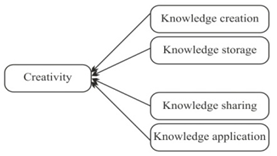 | Figure 1. Conceptual framework |
In this model KM is independent variable and creativity is the dependent variable. According to Hicks Model the four dimensions of KM are; knowledge creation, storage, sharing and application. Jashpara’s model was used in this study to find out the relationship among these variables and creativity.
2. Methods and Materials
This study is an applied one and the used methodology is of correlation type which is a sub category of field and library study. The population comprises 211 managers and clerks. Kochrans method was used to select 136 sample populations. Given that the participants are from six different organizational districts, random sampling classification method was used for selecting them. In order to observe the distribution of sample population properly from different districts, the proportional selection method was used taking into account the number of employees in each district. The selection of sample population from each district was random. Table 1 shows the number of personnel in each district as well as the number of selected sample from each district.Table 1. Classification of sample size on the basis of the proportional selection method
 |
| |
|
3. Data Collection Procedure
Two questionnaires constituting closed questions were used for collecting the data. Both first and second hand information was the sources of the data. The data collection was carried out via library method (books, articles, dissertations, theses, internet, and database) and survey (requesting experts to validate measurement tools). The questionnaires include two sections. The first section devoted to the demographic information of the personnel which is followed by the main questions of the research. The reliability of the questionnaires was measured at standard level and their face validity was confirmed. Cronbach α was used to estimate the inner coherence of the questionnaires. The type of the questionnaire was Likert scale (5 strongly agree, 4 agree, 3 neutral, 2 disagree, 1 strongly disagree). The validity of KM questionnaire was estimated 0.80 and the validity of creativity questionnaire was estimated 0.90 using SPSS version 19. Both of the questionnaires had high validity.Table 2. Research variables
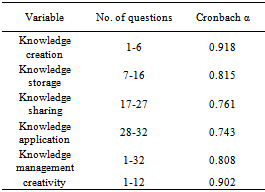 |
| |
|
4. Results
Pearson correlation coefficient and multivariable regression analysis were the statistical analyses used for analyzing the data as well as the statistical tool of SPSS version 19.Table 3. Demographic information of the participants
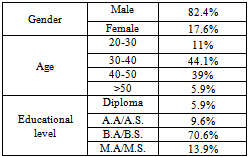 |
| |
|
The descriptive analysis of the dependent and independent variables show that the computed Mean of KM for the personnel is 3.25. Bearing in mind that the optimum degree of KM is 5 and the most undesirable level is 1, the estimated Mean of KM for WSO personnel was higher than average. Regarding the personnel’s creativity, the computed score was 3.62 indicating fairly high creativity. The recorded Mean for the knowledge creation was 3.56 indicating an acceptable level. Similarly, the obtained Mean for the knowledge storage was 3.47, which means over average level. The estimated Mean for knowledge sharing was about 3 (2.96) showing lower than average level of sharing knowledge among the personnel. The mean of knowledge application was estimated 3.04 indicating average level.Kolomogorov-Smirnov test was used to determine the normality of the data. It was used to detect the normality of the understudy variables (i.e., knowledge creation, storage, sharing and application as well as creativity).Table 4. Normality of variables
 |
| |
|
Table 5. Correlation coefficient among variables
 |
| |
|
As the table shows there is no significant difference between the distribution of variables and normal distribution which indicates the normality of the distribution of all variables. Thus, we had to use parametric test for analyzing the proposed hypotheses. In other words, Pearson’s correlation coefficient was used to verify the hypotheses.As illustrated in Table 5, Pearson correlation coefficient between KM and creativity was estimated 0.53 showing a direct relationship between these two variables. To be more precise, the application of KM in an organization will increase the creativity of its personnel. The obtained Pearson correlation coefficient between personnel’s knowledge creation and creativity was 0.53 which indicates a direct relationship between them. In other words, the more new and brand ideas created by personnel, the more creative they would be. According to Pearson’s correlation coefficient, the relationship between knowledge storage and creativity was estimated 0.36 which refers to a direct and average relationship between these two variables. The relationship between knowledge sharing and creativity was computed as 0.36 which indicates direct but lower than average relationship between them. It means that the more personnel share their knowledge, their creativity increases. The correlation coefficient between knowledge application and creativity was computed as 0.44 which indicates direct and average relationship between these two variables. Thus, the more personnel use knowledge, the more creative they are.Following is the results of multivariable regression analysis of the data.Table 6. Summary of Multivariable Regression Analysis
 |
| |
|
As table 6 shows, the correlation coefficient is R= 0.606 which indicates a high correlation among dependent and independent variables. The estimated R square= 0.368 shows that 36.8% of the modifications of dependent variable (i.e., creativity is due to the discussed independent variables in this study). The remaining changes (63.2%) are because of other independent variables which were not discussed in the present study. The four independent variables that affect the creativity of WSO personnel more are presented here in the order of importance:X1= Knowledge creation, X2= knowledge application, X3= knowledge sharingX4= knowledge storage Table 7. Multivariable regression and ANOVA
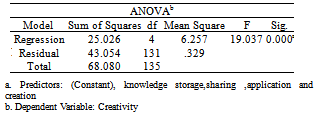 |
| |
|
As it is shown in Table 7, the results of ANOVA for the model obtained from multivariable regression analysis are statistically significant. Another output of regression model is the significance of regression model which is estimated by F. The measured P=0.000 shows the significance of regression model at 99% level.Table 8. Multivariable regression coefficient model
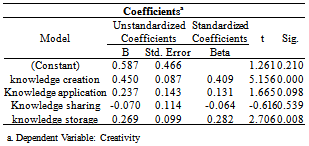 |
| |
|
Table 8 illustrates the coefficient of proposed model in multivariable regression. Beta indicates that knowledge creation has the highest regression coefficient (0.45), while knowledge sharing has the lowest regression coefficient (-0.07). Taking into account the above mentioned facts, a general equation of regression line would be:Creativity= 0.587+ knowledge creation (0.45)+ knowledge application (0.269) + knowledge sharing(-0.07) + knowledge storage (0.237)r= 0.587 + 0.45 X1 + 0.269 X2 - 0.07 X3 + 0.237 X4To identify Beta coefficient path, we will have a close look at the column of important and effective variables.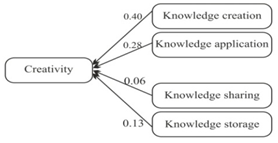 | Figure 2. Analysis of Personnel’s creativity path |
According to the findings of the study, the following suggestions are proposed:A: suggestions for the improvement of creativity in the order of importance:- Creative individuals should be supported by the master directors- Potential use of specialized personnel’s capabilities and experiences- Encouraging personnel to join group work and team learningB: suggestions to improve and increase knowledge creation:- Establishing knowledge project systems, innovation supporting devices, competitive intelligent tools, artificial intelligent systems, intranet (inner organization communication system to exchange information), and weblog (as a feedback to different ideas and insights which takes place very fast).C: suggestions to improve knowledge storage:- Providing the personnel with the information about the development and progress of organization via internet or journalD: Suggestions to improve knowledge sharing in the order of prominence:- Holding meetings biannually, establishing E-journal in the organization’s website- Presenting successful experiences among staff in different districts and the repetition of prosperous experiences- Increasing less experienced personnel’s knowledge by developing link and connection between experienced personnel to transfer their knowledge to the young and new employeesE: Suggestions to improve knowledge application in the order of importance:- Investing and devoting budget to make use of KM and implementing it- programming to absorb elites and experts as the knowledge personnel- Having access to high speed internet and intranet- Teaching the skills of advanced search in net to use KM
5. Discussion and Conclusions
In the present knowledge era organizations emphasize on human capital as a tool to achieve sustainability and competitive privileges by making use of KM. The directors of organizations should steadily encourage their personnel to creativity and innovation. They should try to motivate them in increasing the effective implication of KM in the organization. The results of the study by Hassanbeigi (2010) suggest that sharing of knowledge has positive effect on the organizational creativity. Furthermore, some key factors that affect the success of KM can increase creativity in organizations. According to Ansari (2011), there is a meaningful relationship between KM and creativity. The findings of Tagizadeh and Tarri (2008) show the positive and significant effect of both KM and creativity on the development of organizations. However, KM affects organizational development more than creativity. As aforementioned, all the major and minor assumptions proposed for the present study were validated. The results of multivariable regression analysis showed a high correlation among dependent and independent variables. Whereas 36.8%of the dependent variable (i.e., creativity) is affected by independent variables investigated in this study; there are other variables that affect creativity which were not in the scope of this study.The model used in this study is among the models suggested by KM experts to be used in modern dynamic organizations. In Sum, this organization has to deal with the following issues to be able to make use of the effective processes of KM:- Detecting the strategies that the organization needs to improve and make progress- Investigating the present knowledge of the personnel and the knowledge they need- Evaluating the learning abilities of the personnel- Making use of advanced and up dated soft ware to fill the gap between knowledge creation and knowledge storage- Personnel should participate in such activities as personal study, periodical and in-service trainings, sharing acquired knowledge to change the organization to a learned oneImplications of the StudySuggestions for Further Research- Doing similar researchers in other organizations provides the chance to compare the results with each other.- Similar studies can be carried out in the organizations with similar goals and duties the results of which can be used as criteria to compare with other organizations.- This study can be repeated using different dimensions and models of KM.- To investigate the effective factors on creativity, different dimensions of it can be used for further studies.
ACKNOWLEDGMENTS
Our special thanks goes to West Azerbijan Water and Sewage Organization for their financial support.
References
| [1] | Ansari, M.H., (2011). Knowledge Management and Creativity in Tehran Physical Training General Office. Physical Management. 9, p : 67. |
| [2] | Arabi, M., & Mosavi, S., (2009). Knowledge Management Strategic Pattern to Promote the Performance of Research Institutes. Research and Planning in Higher Education Quarterly. 51, p: 3. |
| [3] | Farnodian, F., (1991,92). Text Content and Research on Students’ Creativity. Journal of Educational Technology, Roshd. 5, 6, 7, Year 6. |
| [4] | Gupta, j, N.D & Sharma, k. Sushil, (2004). Creating Knowledge-based Organization. IDEA group publishing. |
| [5] | Hasanbeigi, M. (2010). Presenting a model of critical success factors of knowledge management for increasing innovation and organizational learning in Iran Airports Company,Payame noor University, Department of information technology. |
| [6] | Stacey, R. (1999). Managing the Unknownable Strategic Boundaries between Order and Chaos in Organizing. Jossey-Bass publishers. |
| [7] | Tagizadeh, H., & Tarri, G., (2009). An Investigation of the Effect of Knowledge Management and Creativity on the Development of Tabriz Islamic Azad University. Industrial Management Quarterly. 7, p: 113-131. |



 Abstract
Abstract Reference
Reference Full-Text PDF
Full-Text PDF Full-text HTML
Full-text HTML






